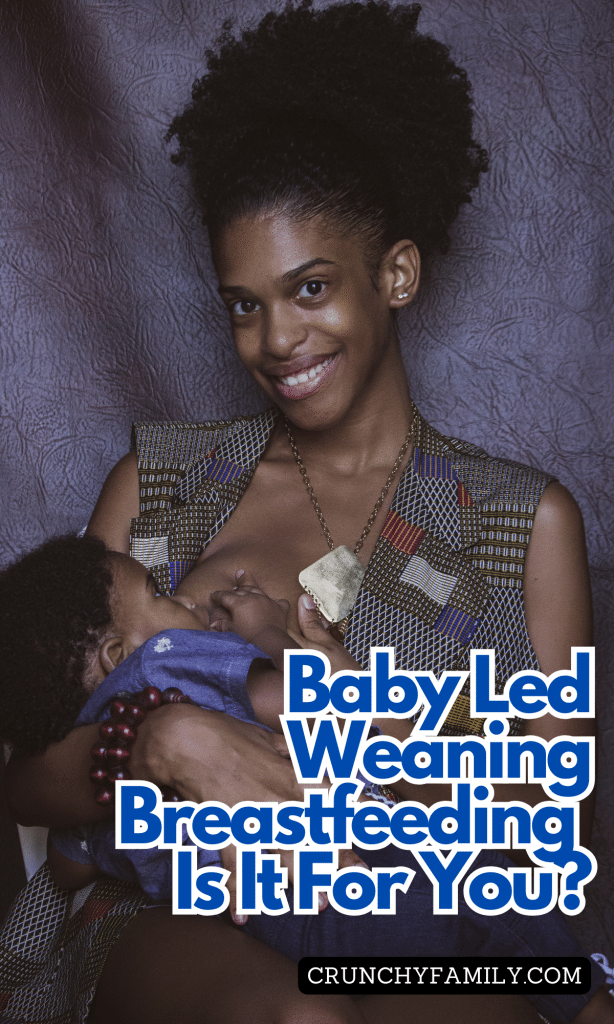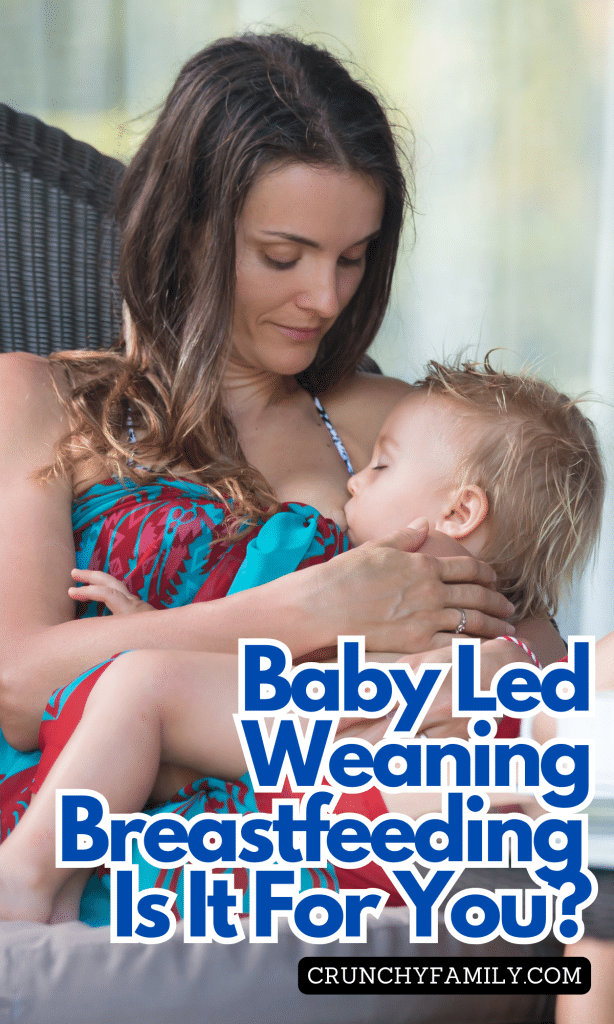When it comes to breastfeeding and weaning, there are so many different approaches. One that has gained a lot of attention and popularity is baby-led weaning.
But what exactly is baby-led weaning breastfeeding, and is it the right choice for you and your little one?

Baby-led weaning is an approach where infants are introduced to complementary foods and allowed to self-feed from the start of the introduction of solid foods, typically around six months of age.
This method skips the traditional spoon-feeding of purees and instead offers the baby small, manageable pieces of family foods. The idea is to let your baby take the lead in their eating journey, exploring new foods at their own pace.
There are several benefits to baby-led weaning breastfeeding. One major advantage is that it promotes the development of fine motor skills and hand-eye coordination as babies learn to grasp and manipulate finger foods.
It also encourages a more varied diet and helps prevent picky eating habits, as babies are exposed to a wide range of textures and flavors from the start.
Baby-led weaning can make mealtimes more enjoyable for the whole family. Instead of preparing separate meals for the baby, you can simply modify the family foods you’re already eating to make them safe and appropriate for your little one.

This approach can also foster a positive relationship with food, as babies learn to recognize and respond to their own hunger and fullness cues.
For those who are breastfeeding, baby-led weaning can complement the breastfeeding relationship nicely. Exclusive breastfeeding is recommended for the first six months of life, after which complementary foods can be introduced while continuing to breastfeed.
As your baby starts to eat more solid foods, you may notice a gradual decrease in the frequency of breastfeeding sessions.
It’s important to remember that breast milk continues to provide essential nutrients and health benefits well beyond the first year.
The World Health Organization recommends breastfeeding up to two years of age or beyond, as long as it is mutually desired by both mother and child.
Baby-led weaning allows for a gradual process where the baby naturally reduces their breast milk intake as they become more interested in solid foods.
Deciding whether baby-led weaning is the best way for your family is a personal choice and depends on your individual circumstances and your child’s needs.

If you decide to try baby-led weaning, here are some tips to help make the transition smooth and enjoyable:
- Start Slow: Introduce new foods one at a time, and in small amounts, to monitor for any allergic reactions.
- Choose Appropriate Foods: Offer foods that are soft in texture and easy for your baby to handle, such as steamed vegetables, ripe fruits, and small pieces of meat or fish. Avoid foods that pose a choking hazard.
- Be Patient: Allow your baby to explore and play with their food. It might be messy, but it’s all part of the learning process.
- Maintain Breastfeeding: Continue to breastfeed on demand. Breast milk will still be a significant source of nutrition and comfort for your baby.
- Involve the Family: Encourage family members to join in mealtimes and model healthy eating behaviors.
- Stay Informed: Keep up to date with infant feeding guidelines and seek advice from trusted sources, such as La Leche League leaders or pediatric nutrition experts.

As you introduce solid foods, you may notice changes in your baby’s nursing patterns. Some breastfed babies might naturally reduce the number of nursing sessions, while others may continue to breastfeed frequently. It’s essential to ensure that your baby is still getting enough milk, whether through breastfeeding or infant formula if needed.
During the early morning, your milk supply is typically higher, which can be an excellent time for nursing sessions to ensure your baby is receiving plenty of mother’s milk. As your baby’s diet becomes more diverse, you might find that they need less milk and more solid foods to meet their nutritional needs.
Sometimes, babies go through periods known as nursing strikes, where they temporarily refuse to breastfeed. These can be challenging, but they don’t necessarily mean it’s time for weaning.
Patience and offering the breast during calm, one-on-one time can help overcome these phases. If partial weaning is your goal, gradually reducing the frequency of breastfeeding while introducing more solids can be a good idea.
Natural weaning, or child-led weaning, happens when your baby loses interest in breastfeeding over time, often coinciding with their growing interest in solid foods.

This process can extend well beyond the first birthday and varies from child to child. It’s a gentle and gradual way to wean, respecting your baby’s own time and pace.
For some families, mother-led weaning, where the mother gradually reduces nursing sessions, might be more practical. This can be particularly relevant if you’re facing a new pregnancy or if there are medical conditions affecting your milk production. Consulting with a lactation consultant or healthcare professionals can provide tailored advice and support during the weaning process.
If you’re considering formula feeding as part of your weaning strategy, it’s important to transition gradually. Introducing small amounts of infant formula alongside breastfeeding can help your baby adjust to the change. Formula feeding can also be a practical alternative if you’re returning to work or if your milk supply is insufficient.
Ensuring that your baby’s diet meets their nutritional needs is crucial during weaning. Offer a variety of first foods rich in iron, such as infant cereal, meat, and beans, to prevent iron deficiency. Introducing cow’s milk is generally recommended after the first year of age, as it can be harder for younger babies to digest.
Soft textures and smaller pieces of food are ideal for young children learning to eat. Avoid giving fruit juice and opt for water or milk as healthier options. Peanut butter, spread thinly on bread or crackers, can be a nutritious addition to your baby’s diet, but always watch for any allergic reactions.

Baby-led weaning breastfeeding is an approach that allows your baby to explore new foods and self-feed from an early age. It can be a rewarding and enjoyable experience for both you and your baby, fostering independence and a positive relationship with food.
However, it’s important to consider your family’s unique needs and circumstances when deciding if this method is right for you.
Whether you choose baby-led weaning, a more traditional approach, or a combination of both, the most important thing is to ensure that your baby receives the love, support, and nutrition they need during this critical period of growth and development.
More related reads:
- Breastfeeding Is Not Supposed to Be Painful
- On Demand VS Scheduled Breastfeeding: Which One Is Best For you?
- What to Wear to Bed When Breastfeeding
- Breastfeeding Is Easy! Don’t let people tell you otherwise
- What are the Benefits of Comfort Breastfeeding?
- 17 Effective Ways To Reduce Anxiety When Breastfeeding
- Pros and Cons Of Extended Breastfeeding: A Personal Journey
- When Does Breastfeeding Get Easier?